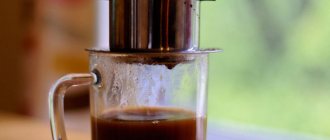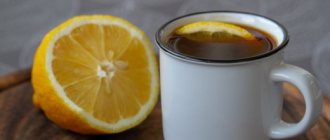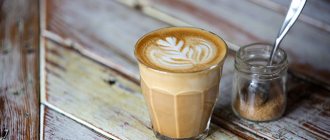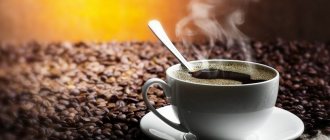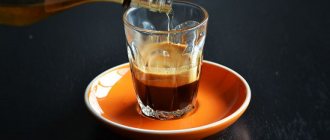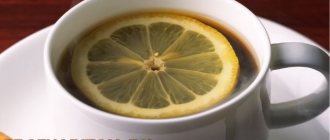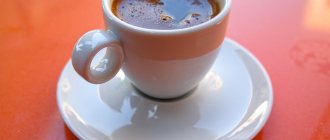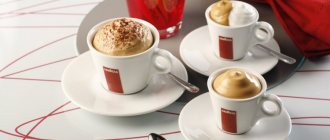The taste and aroma qualities of a coffee drink depend primarily on the type of beans chosen. Also, these characteristics are influenced by what the coffee is brewed in. There are several types of cookware and devices that can be used. To achieve good results, it is extremely important to choose these devices correctly.
What is coffee usually brewed in?
There is more than one name for cookware for making coffee. In the United States of America alone, about eight hundred patents have been issued for various variations of coffee makers. Essentially, all these devices are divided into two types:
- electrical;
- slab
Slabs require heating. The dishes are placed on the stove. Electric ones simply need to be connected to the mains.
There are both simple devices that have been used for centuries, and modern units that perform many functions, including grinding beans and choosing the optimal dosage.
Pourover and its varieties
The ritual of making coffee is called a “coffee ceremony.” It requires time, concentration on the process and all kinds of accessories. But the main thing is compliance with special technology.
Pour over is a method of brewing coffee in a filter funnel by slowly passing hot water through the ground beans. It is also called Hario in honor of the Japanese company Hario, which is considered the main manufacturer of pour-over funnels.
The name comes from the English pour over - “pour”, “pouring from above”.
At the moment there are several types of devices. They differ not only in manufacturers, but also in appearance:
- The classic Hario V60 funnel looks like a coffee cup with a handle and a hole in the bottom. The designation V means the shape of the device, and 60 is the angle at which the walls of the Hario funnel are inclined to the bottom. There are longitudinal convex ribs inside to prevent the filter from sticking to the side surface of the dripper.
- Kalita Wave differs from Hario in the presence of three small holes instead of one large one; the ribs of Kalita are located horizontally. The company also produces special pleated filters for the dripper. As a result, coffee is brewed and aromatic components are extracted more evenly. But the price of the Kalita pour-over is 3 times higher than the Hario.
- The December Coffee Dripper already has as many as 12 small holes in the bottom. The base rotates, which allows you to close/open the holes and adjust the speed of flow of the finished extract.
- Clever Dripper is characterized by the presence of a valve. Thanks to this feature, coffee can be steeped by opening the valve at the right time.
Other Alternative Coffee Brewing Methods
Alternative methods of making coffee are popular today, many of them similar to pour over:
- A Chemex looks like a glass vase or hourglass and consists of a funnel with a filter and a flask with a spout. The drink turns out less aromatic than in a pour-over, because the filter fits tightly to the smooth walls of the funnel.
- Percolator – liquid for about 10 minutes. passes through the filter, the coffee is boiled several times. The result is a low-quality drink with bitterness.
- The Vietnamese filter works simply - add hot water to the powder and wait 5 minutes. The coffee turns out tasty, but cold.
- Cold brew takes 10 hours or more to prepare the drink. It works by cold filtering water through ground coffee. The result is an intense drink with a rich aroma, completely free of bitterness and sourness.
Cooking in Turk
The oldest and simplest way to prepare a coffee drink, which is still widely used today, is boiling the beans in a Turk (cezve). Already from the name it becomes clear that this dish was invented in eastern countries. They initially used ordinary saucepans to brew the drink, and then for convenience they decided to remove one of the handles. The one that remained was made longer, curved and flattened.
Over time, the Arabs noticed that if the container at the neck was made narrower and the edges widened, the coffee would be much tastier. Thus, dishes with a thickened bottom, a narrow neck and a long handle were invented. She quickly gained popularity all over the world.
Nowadays, Turkish coffee is prepared on a stove (gas or electric). The classic recipe involves brewing in hot sand. The following actions are performed:
- The sand is heated for several hours.
- A Turk filled with coffee and water is immersed in it up to the level of the neck.
- When the water approaches the point of boiling, the cezve is quickly removed.
- To fully develop the taste and aroma, such manipulations are repeated 3-4 times.
For those who like to prepare a drink according to the classic recipe, a special electrical appliance has been developed. Visually, it resembles a box filled with sand. When it is turned on, the contents of the container become hot. All that remains is to place the cezve there.
If you have no experience in making coffee, it is recommended to start mastering this process with a copper or ceramic Turk.
Initially, only one type of grain is used. Then you can switch to mixtures and add various spices to the composition.
Commercial coffee machine CRM 2032
If you are thinking about opening your own mini-coffee shop, then the first thing you will need is a commercial-grade coffee machine. These are more expensive than home options, but differ from them in greater power, tank volume and performance. In the CRM 2032 model, preparing 1 cup of coffee takes only 1 minute, and in 1 hour of operation the machine is capable of dispensing 100 cups. The machine is controlled using large switches.
$698.05 | Buy
Top
Coffee pot
This coffee brewing container was invented in England at the end of the eighteenth century. Since then, the simple device has been constantly improved. Some coffee pots are used by brewing the beans on the stove, while others run on electricity. Despite many new, more modernized designs, these continue to remain popular among coffee lovers.
Coffee machine with screen
Unlike the previously mentioned coffee machine options, here the functions are controlled using an icon interface on a 3.5-inch touch screen. The power of the device is 1250 W, and the water tank has a volume of 1.7 liters. The coffee compartment holds 250 grams. The maximum pressure inside the device is 19 bar. Preparing 1 serving of espresso takes only 30 seconds. There is an automatic cleaning system.
$630.70 | Buy
Top
French press coffee maker
Invented in France in 1920, the device for brewing coffee is very popular. The coffee maker looks like a tall glass container made of high-temperature resistant material. Equipped with a piston. The lower part of this design part is connected to a metal filter, which looks like an ordinary mesh and fits tightly to the glass walls. At the top, the piston is attached to the cover.
The device is heated, and then coarsely ground coffee beans are poured into it and hot water is poured. After five minutes, the piston is slowly lowered down. Due to this, there is no grounds in the finished drink.
Hario coffee brewing unit
No, this is not a moonshine still, but just another original way to make delicious coffee without using electricity. Harion is a Japanese siphon consisting of 2 communicating transparent containers, which are placed on one vertical stand. At the bottom there is a burner for heating using solid fuel. At one time, you can prepare up to 360 ml of coffee, which is enough to feed 2-3 people.
$53 - $58 | Buy
Top
Geyser coffee maker
This device is especially popular among residents of Italy. The appearance of the unusual invention dates back to 1927.
The structure consists of three elements. The bottom section contains water. Above it is a raw materials compartment. The upper part is intended for the finished drink. To brew coffee, the device is placed on the stove. In this case, strong pressure is generated in the lower part. Steam begins to pass through the crushed grains located in the middle section. After this, it enters the upper compartment, cools down and goes through the condensation stage. The thicket continues to be located in the center of the structure. The drink turns out rich and quite strong.
RATING OF TURKS FOR COFFEE: BEST MANUAL COFFEE MAKERS
RATING OF TURKS FOR COFFEE: BEST MANUAL COFFEE MAKERS
| Model | Production Country | What is it made of? | Displacement (l) | Dimensions D/H | Color |
| Copper Turk – 0.3 l | Türkiye Russia | Copper alloy | 0,30 | 6.5/7 8,L=28 cm | Gold |
| Brand "Mrs" | Türkiye Russia | Copper | 0,13 | 4.5/5.5 6.5,L=18 cm | Gold |
| Series “SOY” An exciting day | Russia Türkiye | Copper alloy | 0,40 | 7/7 10,L=16 cm | Golden |
| Frabosk for 6 persons | Italy | Stainless steel | 0,50 | Height 11 cm | Silver Mirror |
| SOY G3 | Türkiye | Copper alloy with silver | 0,20 | Height 11 cm | Golden-silver |
| Nickel Turk | Russia Türkiye | Nickel alloy | 0,35 | 6.5/9 10,L=15.5 cm | Silver |
Drip coffee maker
It is very convenient to brew coffee in a drip coffee maker. It is also known as American filtration. The invention appeared thanks to the efforts of the archbishop of Paris in 1800. The device is equipped with a heating circuit through which water moves, which eventually reaches a temperature of about 90-95 degrees. After this, the liquid begins to flow one drop at a time into a filter filled with crushed grains. When the coffee releases its aroma sufficiently, the liquid flows into the flask.
One of the important design details is the filter. It can be disposable (made of paper) or reusable (nylon).
Often, a filter made of nylon is additionally coated with titanium nitrate. Due to this, its service life is significantly extended.
Coffee lovers who prefer a strong coffee drink are recommended to give preference to coffee makers with low power (within 750-850 W). The liquid in such a unit will heat up more slowly and absorb the maximum amount of aromatic substances. This makes the coffee richer.
Piston coffee brewer
Price RUB 1,304.50
A piston teapot made of stainless steel is a jug-shaped vessel with double walls separated by a layer of air. Stylish, available in three container sizes.
PRICE FOR ALIEXPRESS
Coffee mill
A very practical, manual coffee grinder will provide you with a portion of ground product that can make your drink even tastier. It has a convenient design for easy storage. Easy to use, no problem keeping the mill clean.
PRICE FOR ALIEXPRESS
Conical filter
Price 776.31 rub.
Reusable coffee filter, stainless steel. It is easy to keep the filter clean; just rinse it under running water. Dimensions 110x89mm.
PRICE FOR ALIEXPRESS
Mug for boiling milk
Price 696.00 rub..
Espresso coffee maker
The drink is prepared using steam pressure. This unit can also make cappuccino. To froth milk, you need to place a straw equipped with a nozzle in a container with liquid. Steam will begin to flow through it under pressure. Due to this, foam will appear on the brewed coffee.
The unit works according to this principle:
- the water gradually warms up;
- when the maximum pressure is reached, the valve opens;
- the liquid moves through the tank containing the grains.
Depending on the device model, you can prepare 2-4 cups at a time. Designs that create a pressure of 15 bar are more advanced than those designed for only 3.5-5 bar. In them, the liquid absorbs a maximum of aromatic substances.
For this type of coffee maker, it is recommended to use a special type of product. It's called espresso. These are coarsely crushed grains that have undergone special heat treatment.
Semi-automatic coffee machine
One of the most affordable methods to get a cup of regular espresso is to use an espresso machine. Unlike expensive units, this $100 unit is semi-automatic and designed for a pressure of 20 bar. The machine is controlled using just 3 buttons and a dial. The safety of the device is ensured by a complex of protection against overheating. At the top there is a platform for storing and heating cups.
$99 | Buy
Top
Combination coffee maker
A combination coffee maker combines two types of devices. One of them is drip type. She is able to prepare a liter of an invigorating drink at once. The other brews just one cup of espresso. Such units are equipped with a special device designed for whipping dairy products.
These designs are suitable for coffee lovers who find it difficult to decide on their preferences and choose between espresso or traditional coffee. They are convenient to use in a small kitchen. Such devices save space.
These coffee makers also have disadvantages. Among them are the following:
- each part of the unit requires special care;
- you have to purchase different types of ground grains;
- high price. For the same money you can buy an espresso and drip device of decent quality separately.
There are a huge number of devices designed for brewing coffee. Each of them has a number of advantages and disadvantages. It is impossible to say unequivocally what is best to brew coffee beans in. Disputes on this matter continue constantly. Some people prefer the drink prepared in a cezve or French press. Other coffee lovers claim that it is much easier to brew it in modern units.
What is dalla for coffee
Dalla (dalle) is the Arabic name for a small coffee pot, which is traditionally used to prepare very finely ground coffee over an open fire or in hot sand. Once the inhabitants of the Persian Gulf and the Middle East became acquainted with coffee, the drink became an important part of the culture. Over a small cup, serious life issues were and are still being resolved - from marriage to a trade deal. The drink was first brewed in tall Bedouin water jugs called ibrik. But this was not very convenient, since the thin handle quickly warmed up, and the too long spout became clogged with coffee. Therefore, Arab artisans quickly came up with their own design of dishes that would preserve the temperature and taste of the drink for a long time, and also reflect the national flavor. This is how practical and sophisticated dalls appeared, which are still considered the national symbol of many Arab countries.
The oldest dalls were discovered in the southern part of the Arabian Peninsula, where they most likely came with the nomadic Bedouin tribes. Such dishes are at least 400 years old.
Types of cups
In the classification of coffee utensils, in addition to the material, there are a number of other parameters.
Volume
As a general rule, the measurement of drinking liquid is determined by the capacity of a glass that is not filled to the brim.
The world standard contains the following volumes:
| 4oz / 118 ml | small | for espresso |
| 8oz / 237 ml | middle | with American coffee |
| 12oz / 355 ml | standard | universal |
| 16oz / 473 ml | large | double cappuccino, compound drinks |
Russian manufacturers adhere to a different format:
- 100 ml cups are used for strong espresso, in tasting mode, for presentations and branding.
- Vending machines charge glasses with a capacity of 150 to 205 ml.
- Kraft is most often represented by a line of 100, 250 and 350 ml.
- At points of sale of hot and cold coffee drinks, volumes of 0.28–0.4 liters or more are popular.
- The most common is the 250 ml container.
Structure
Manufacturers of disposable paper tableware apply the standards of the cardboard used to make them. The container capacity and the density of the material are related as follows:
| Cup, ml | 60-110 | 170-175 | 200-400 | 450-750 |
| Cardboard, g/m2 | 195-205 | 205-225 | 184-260 | 245-265 |
According to the structure, paper types of coffee cups are single-layer, two-layer, three-layer and corrugated. Suitable for both cold and hot liquids. The main difference is how long they do not get wet and maintain the original temperature.
- Single-layer glasses are the most popular and cheapest type of glasses.
- Double-layer coffee cups are widely used in the takeaway trade.
- Three-layer craft ones have increased strength. They are in demand in coffee shops of hypermarkets and multiplexes.
- Corrugated coffee cups do not deform, thanks to the ribbed surface they do not slip out of your hands, and they retain heat better than others.
Texture
The outside of coffee utensils can be smooth, rough or grooved. Its shape and large contact area help to hold a smooth glass. The embossed surface prevents the container from falling out of your hands.
By the way, coffee lovers from Sao Paulo, Brazil, found that the personal perception of what they drink is influenced by various factors, including tactile sensations. Tasters rated the coffee in the smooth cup as sweet and drinkable. And in exactly the same one, but from a rough glass, we noticed a bitterness and a dry aftertaste.
Color
For a long time, the main color of coffee utensils remained and remains white. When the cup contrasts with the contents, and not only from the inside, but also from the outside. This allows you to perceive color, feel richness, and give other organoleptic quality assessments.
Today, the color palette of cups amazes with its imagination. Company logos are applied to them and decorated in the style of themed events and holidays. Often the design is in the colors of the coffee brand (juicy blue Lavazza, bright Jet ornament, red tones for To go and Waffle Craft). Craft tableware is usually brown. Black glasses have become a trend in coffee shops; you can write on them with markers.
At the Campinas Research Center, a psychological experiment was conducted in which participants drank the same type of coffee from cups of different colors. The taste from the yellow container was rated as sweet and sour. The green color brought sourness to the drink. The coffee in pink cups seemed sweet.
The widespread use of shades of brown is not only associated with the appearance of roasted coffee beans. This color is associated with earth, ecology and naturalness. By the way, please note: even when coffee to go is in white cups, they sometimes have a brown ring made of cardboard or recycled paper on them.

